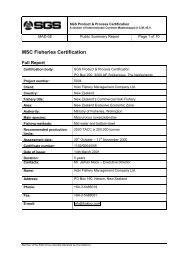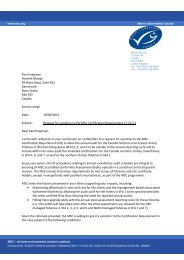SGS Product & Process Certification - Marine Stewardship Council
SGS Product & Process Certification - Marine Stewardship Council
SGS Product & Process Certification - Marine Stewardship Council
Create successful ePaper yourself
Turn your PDF publications into a flip-book with our unique Google optimized e-Paper software.
the bass trawl fishery and the possibilities for improving their exploitation pattern as part of the harvest strategy. The only reference I could find to trawl<br />
meshes was in 9.2.3 – the PSA step 2 – susceptibility, where a high risk score of 3 was correctly given. Perhaps the P1 assessor could add any relevant<br />
trawl mesh information to the appropriate section of the report and discuss the implications for bass stock status. Mesh size controls for towed gears in<br />
which bass is a target species are included in <strong>Council</strong> Regulation 850/1998, but most bass are taken as a by catch in gears for which mesh size<br />
controls depend on other target species. Text amended to clarify.<br />
The current harvest strategy has no mechanism to control fishing effort in the event of a need to reduce fishing effort to combat a fall in stock abundance<br />
resulting from excessive fishing effort or natural climatic changes. It would be wrong to assume that the bass stock will continue to expand its range<br />
and abundance in response to the favourable changes in sea temperature that have taken place in the recent past. Agreed, but the harvest strategy is<br />
designed to achieve management objectives in terms of yield per recruit and MSY, since growth overfishing rather than recruit overfishing has been<br />
identified as the principle cause of loss of production in sea bass stocks (in which a wide variability in recruitment is related to environmental factors<br />
rather than SSB). In this way the harvest strategy is responsive to the state of the stock (protecting year classes for up to 5 years before they recruit to<br />
the fishery and spawning population), and we consider that the SG 80 are met (since analysis and simulations have demonstrated the elements of the<br />
harvest strategy have been work together to achieving the management objectives: see Pawson et al., 2005; Pawson et al, 2007 and ICES 2010).<br />
Based on the above comments SG 1-80 is not met as the harvest strategy does not have explicit mechanisms to respond appropriately to a change in<br />
the state of the stock using effort control and/or mesh size increases. This score should be





